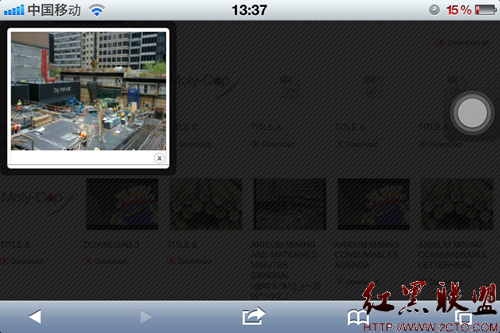在SDK中打开其他接入应用的解决方案
一直以来,在iOS的开发中,在程序中打开另外一个应用是不允许。后来有正义之士用class-dump在私有API中找到了这样的功能。那就是使用UIApplication的launchApplicationWithIdentifier:suspended:来打开。
使用的办法如下:
NSString *identifier = [[NSBundle mainBundle] objectForInfoDictionaryKey:@"CFBundleIdentifier"];
[[UIApplication sharedApplication] launchApplicationWithIdentifier:identifier suspended:NO];
毕竟是私有API不是一个好的办法,至少你永远都得不到App Store的认可。
在某些时候是其实我们可能还是需要这样的功能。作为一个SDK,其实还是有一种比较好的解决方案的。那就是使用UIApplication的openURL:的方法。
我们先来了解一下openURL和实现的方案。OpenURL其实是有很丰富的功能,除了简单的调用safari打开网站,还可有google地图搜索,Mail,拨打电话,发送短信,打开AppStore。
-(IBAction)openMaps {//打开地图
// Where is Apple on the map anyway?
NSString* addressText = @”1 Infinite Loop, Cupertino, CA 95014″;
// URL encode the spaces
addressText = [addressText stringByAddingPercentEscapesUsingEncoding: NSASCIIStringEncoding];
NSString* urlText = [NSString stringWithFormat:@"http://maps.google.com/maps?q=%@", addressText];
// lets throw this text on the log so we can view the url in the event we have an issue
NSLog(urlText);
[[UIApplication sharedApplication] openURL:[NSURL URLWithString:urlText]];
}
-(IBAction)openEmail {//打开mail
// Fire off an email to apple support
[[UIApplication sharedApplication] openURL:[NSURL URLWithString:@"mailto://devprograms@apple.com"]];
}
-(IBAction)openPhone {//拨打电话
// Call Google 411
[[UIApplication sharedApplication] openURL:[NSURL URLWithString:@"tel://8004664411"]];
}
-(IBAction)openSms {//打开短信
// Text to Google SMS
[[UIApplication sharedApplication] openURL:[NSURL URLWithString:@"sms://466453"]];
}
-(IBAction)openBrowser {//打开浏览器
// Lanuch any iPhone developers fav site
[[UIApplication sharedApplication] openURL:[NSURL URLWithString:@"http://itunesconnect.apple.com"]];
}
那怎样来制作从一个应用打开其他应用,这其实很简单,打开info.plist,添加一项URL types,展开URL types,再展开Item1,将Item1下的URL identifier修改为URL Scheme,展开URL Scheme,将Item1的内容修改为myapp其他程序可通过myapp://访问此自定义URL。
其实就是类似下面的样式。
这样就只要open这个应用的自定义url,系统就可以帮我们找到并打开这个程序。
NSURL *url = [NSURL URLWithString:@" myapp:"];
[[UIApplication sharedApplication] openURL:url];
作为SDK比普通应用的优势在于,每一个接入的应用都有一个AppId用于区分,我们就可以充分利用这个AppId来制作。
我们可以要求第三方开发者需要在他们Info.Plist中配置这样的字段,这样我们就可以在我们的SDK界面中打开对应AppId的应用,当然,这需要设备中真的有安装这个程序。
例如某应用分配AppId为111122223333,我们要求其再Info.plist定义URL Schemes为NDSDK111122223333,这样,我们在内部代码就可以准确识别是否有这样的程序。
更有甚者,我们可以通过canOpenURL这个方法来判断这台设备是否安装了这个应用,如果可以打开,返回YES,那应该是有安装这样的程序,不管是ipa还是Pxl的程序,应该都是没有问题的。
如果我们真的选择这样子做,那就需要在文档中说明清楚。但是需要注意的是,也许作为程序员,可能不是很喜欢看文档,也许你费尽心思写的文档他并没有看到。这时我们应该来一点强硬的手段,于是有了下面这段代码的功能。
1:检查用户是否配置了AppId
2:有没有准确配置Info的CFBundleURLSchemes字段
3:是不是可以正确打开。
// Check App ID:
// This is really a warning for the developer, this should not
// happen in a completed app
if (!kAppId) {
UIAlertView *alertView = [[UIAlertView alloc]
initWithTitle:@"Setup Error"
message:@"Missing app ID. You cannot run the app until you provide this in the code."
delegate:self
cancelButtonTitle:@"OK"
otherButtonTitles:nil,
nil];
[alertView show];
[alertView release];
} else {
// Now check that the URL scheme fb[app_id]://authorize is in the .plist and can
// be opened, doing a 易做图 check without local app id factored in here
NSString *url = [NSString stringWithFormat:@"fb%@://authorize",kAppId];
BOOL bSchemeInPlist = NO; // find out if the sceme is in the plist file.
NSArray* aBundleURLTypes = [[NSBundle mainBundle] objectForInfoDictionaryKey:@"CFBundleURLTypes"];
if ([aBundleURLTypes isKindOfClass:[NSArray class]] &&
([aBundleURLTypes count] > 0)) {
NSDictionary* aBundleURLTypes0 = [aBundleURLTypes objectAtIndex:0];
if ([aBundleURLTypes0 isKindOfClass:[NSDictionary class]]) {
NSArray* aBundleURLSchemes = [aBundleURLTypes0 objectForKey:@"CFBundleURLSchemes"];
if ([aBundleURLSchemes isKindOfClass:[NSArray class]] &&
([aBundleURLSchemes count] > 0)) {
NSString *scheme = [aBundleURLSchemes objectAtIndex:0];
if ([scheme isKindOfClass:[NSString class]] &&
[url hasPrefix:scheme]) {
bSchemeInPlist = YES;
}





